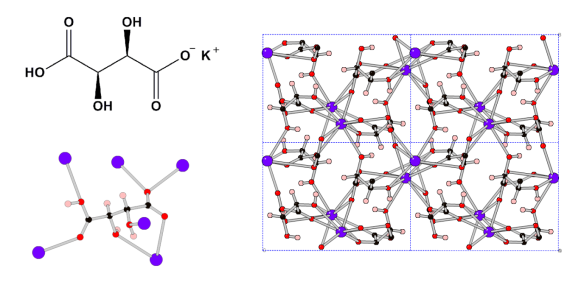Something for the Weekend – Potassium Bitartrate
Dr Dave Turner tells us about the crystals that he'll be looking at this weekend:
What does it look like?

Image generated with Crystal Maker software http://www.crystalmaker.com/
What is it?
Whilst thinking about the weekend ahead it occurred that I will be, as will many others, staring some at some fantastic crystals whilst trying not to choke on them and boring those around me whilst I state how wonderfully they will diffract. (Note – not everybody does this, only those of us who get excited by crystals.) The crystals I am referring to are "wine diamonds", the crystalline precipitate that is sometimes found at the bottom of a bottle of wine and, with shoddy pouring, in the bottom of a wine glass.
Whilst some people are concerned by the sight of these crystals there is absolutely no need for concern. The crystals are potassium bitartrate, a derivative of tartaric acid and commonly called 'cream of tartar' in cooking. The crystals are completely non-toxic and tasteless and therefore have no detrimental effects to the wine, nor do they in any way reflect the quality of the wine. The combination of tartaric acid and potassium from the grapes can, under the right conditions, give rise to crystallization. This can also occur from grape juice and in grape jam making. The tartrate contains many oxygen atoms which can attach to the potassium ions, with six potassium ions around each tartrate giving rise to a complicated 3D network which aids precipitation.
Many large companies process the wine to remove the potassium bitartrate prior to sale, to prevent people from thinking that there are shards of glass in their bottle. But now that you know better you can sit back, relax and enjoy the wine that you’ve worked so hard to earn . . .
Where did the structure come from?
Whilst there have been many structure determinations of this compound, the data used to generate the diagram above was reported in 2000 by Degen, Rothenbutcher and Bolte in a private communication to the Cambridge Structural Database (ZZRZW05). This data was chosen as the experimental details specify that the crystals were grown from grape juice!






